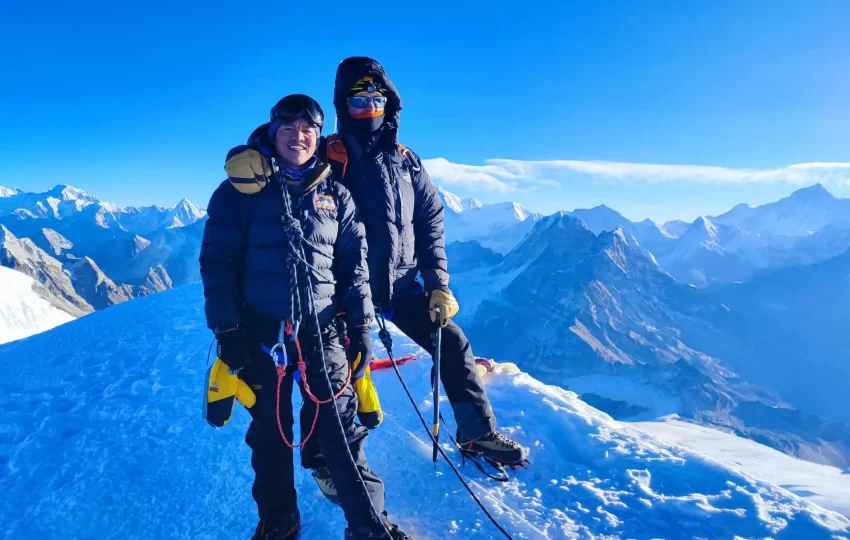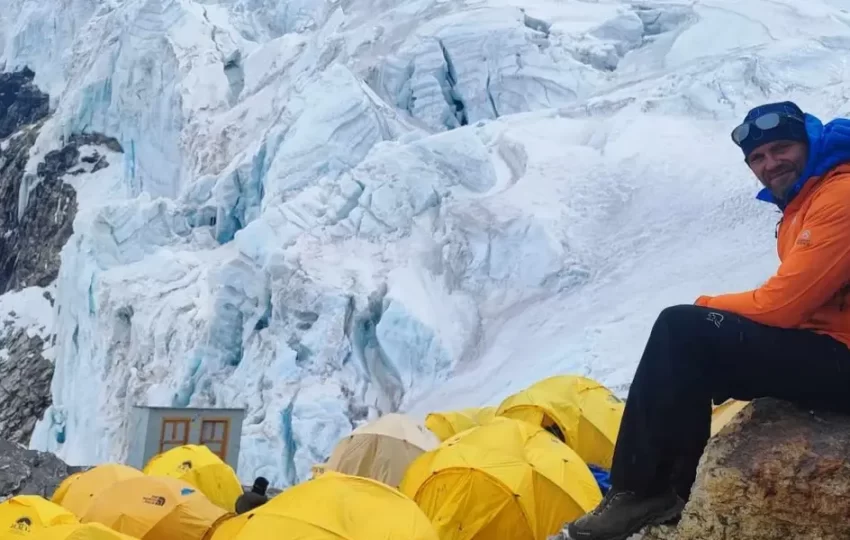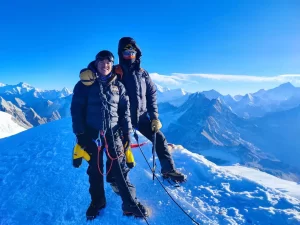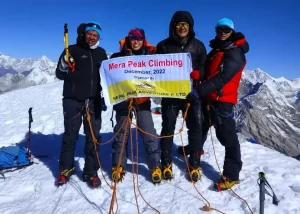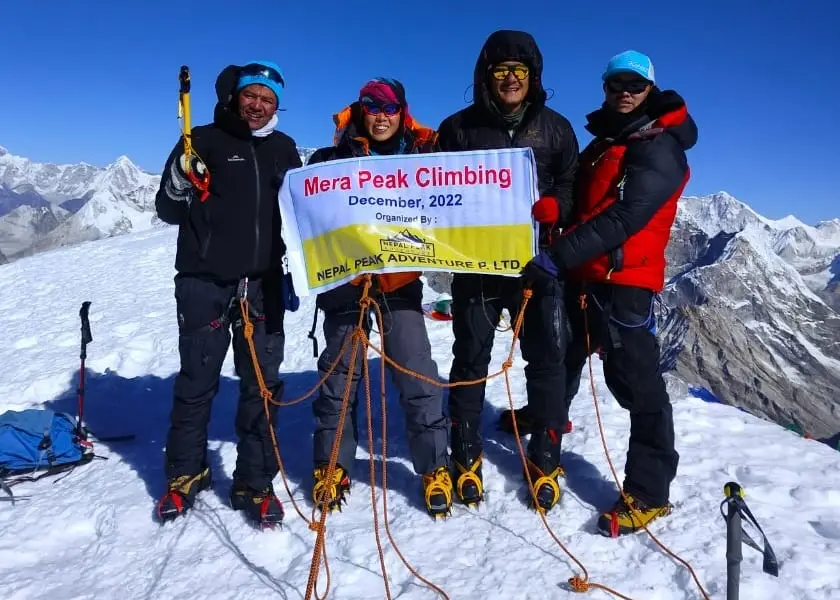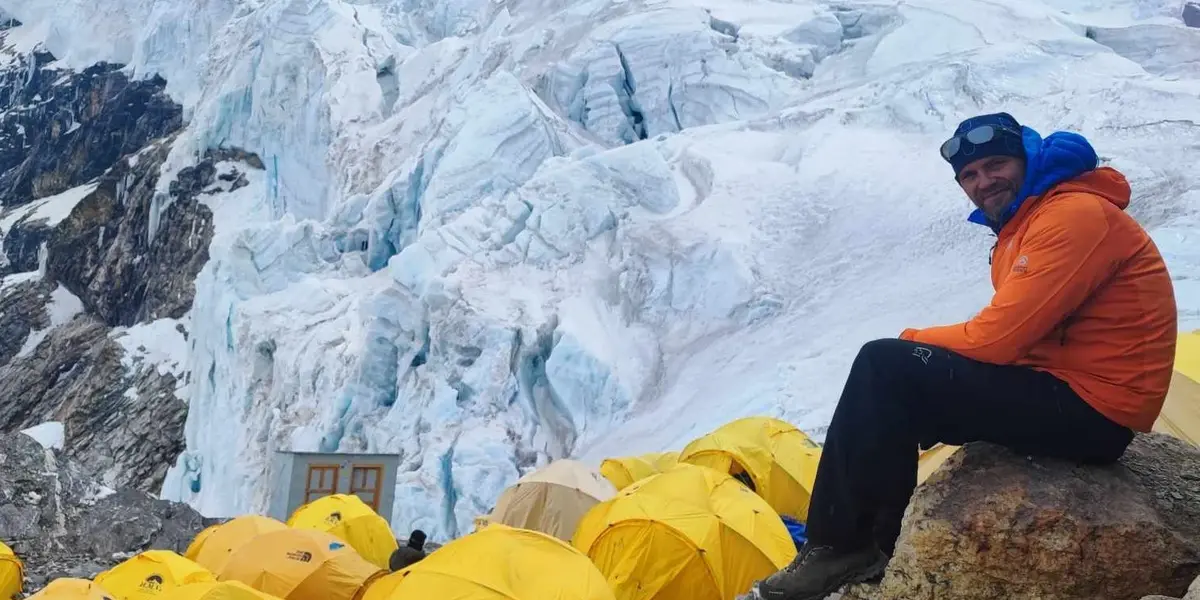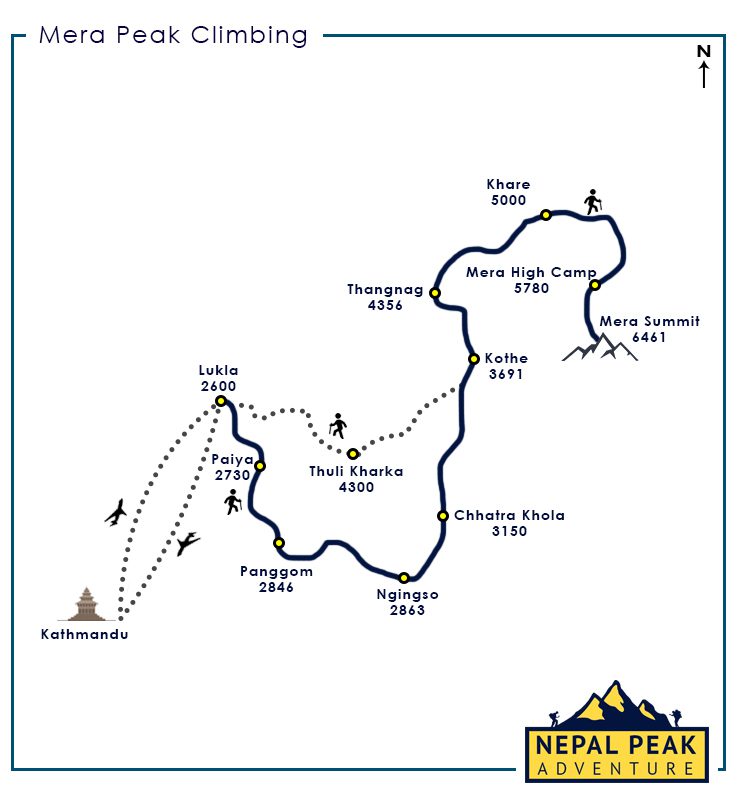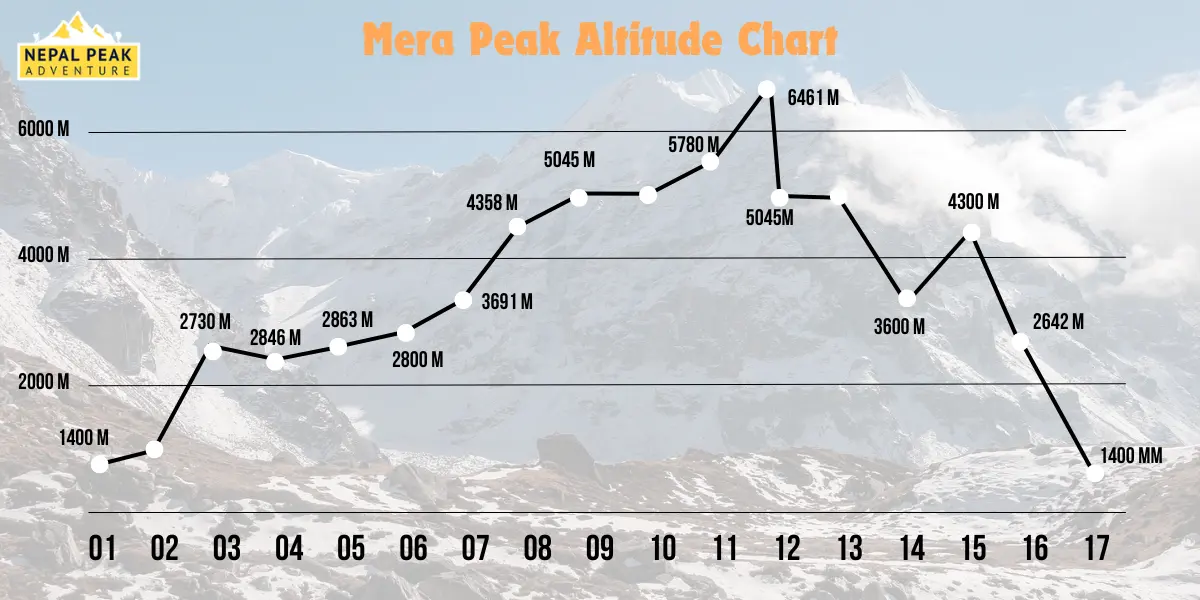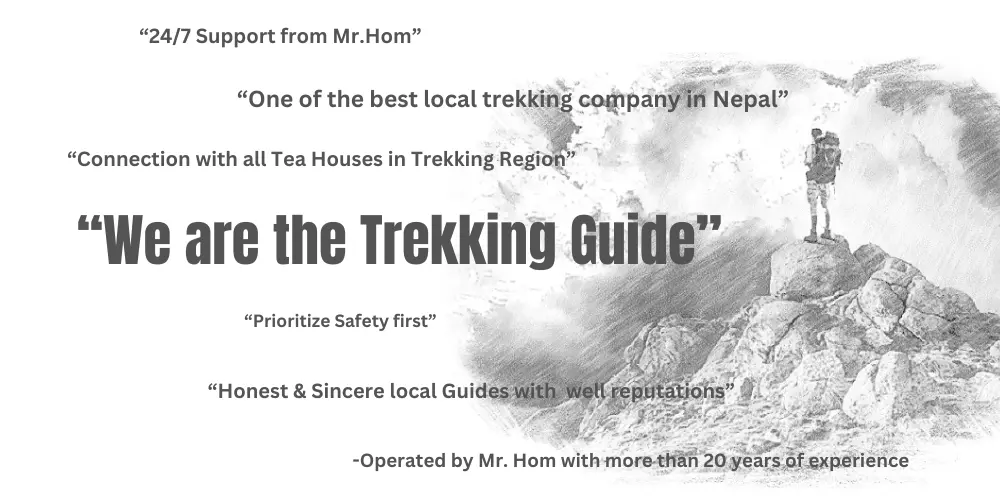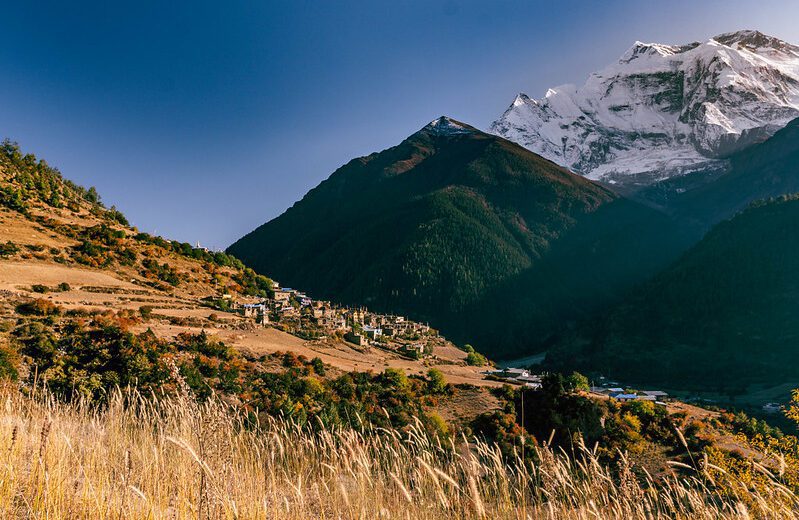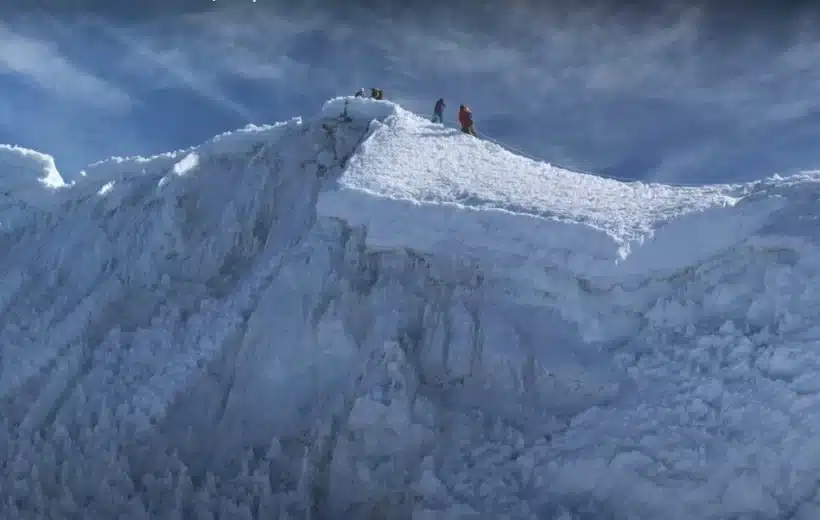Why not Mera Peak Climbing in your bucket list after a tough trekking adventure in Nepal? The experience will be unreal and the achievement will be a talk for years.
But let’s be real, conquering a 6,476m (21,247 feet) will be a challenging fret and 18 Days itinerary is a no joke at all.
That said, with an 80-90% high success rate in Mera Peak Climbing, we can take you to the peak of Mera because it’s what we are here for. The reaming percentage comes from your effort which is not a big deal.
In this 18 Days itinerary Mera Peak plan, we have covered all the fundamental requirements for climbers like:
- Acclimatization schedules
- Climbing techniques
- Gear Lists
- Guides & Porters
- Food & Accommodation
Starting with the basic information that you need to know about Mera Peak:
- Mera Peak Difficulty Level: Moderate to Challenging level, suitable for trekkers with some prior experience in high-altitude climbing. It involves basic mountaineering skills, including the use of crampons and ice axes on steeper sections
- Climbing Season: The best times to climb Mera Peak are during spring (March to May)and autumn (September to November) when weather conditions are more stable
- Permits: Mera Peak climbing permit, Sagarmatha National Park Entrance Fee.
- Key Techniques Required: Use of Ice Axe & Self-arrest, proper use of crampons on icy terrain, Effective use of trekking poles
- Oxygen Requirements: Supplemental Oxygen is generally not required for Mera Peak. However, climbers should be aware of altitude sickness symptoms and take precautions such as gradual ascent and hydration
- Summit Day Preparations: Summit starts early in the morning (around 2 Am) to reach Mera Peak before noon
So, why Mera Peak? What’s the big deal?
You may know Mount Everest as the tallest mountain in the world, but among trekking peaks, Mera Peak is the highest. Cool right?
Talking about the experience, adventure, thrills, suspense – Mera Peak has got it all & without the technical requirements that you might find on other peaks. It also has the highest success rate among other peaks.
However, peak is a peak, and you will still need some solid preparation, both mentally and physically. Only then, you will finally enjoy the 360-degree panoramic views of five of the world's six tallest peaks: Mount Everest, Kanchenjunga, Lhotse, Makalu, and Cho Oyu.
Mera Peak Climbing Overview:
Mera Peak Climb is considered as one of the adventurous & non-technical climbs that rises to the south of Mount Everest. But this climb is not for couch potatoes.
How tough is it? Difficulty Level
According to Alpine Grading System, Mera Peak Climb is graded as PD, meaning it possess some challenges that even veteran trekkers will find it hard. However, the route to the summit is generally non-technical, making it suitable for novice climbers who have some trekking experience.
The toughest part? The altitude.
After crossing above 3,500m high altitude, there is always a risk of altitude sickness. That’s why an acclimatization schedule is very important. We have acclimatization on Day 10.
Similarly, Day 12 will be the most challenging day during Mera Peak Climb which involves ascent to the summit.
The final section of the climb is steep and requires careful navigation, often involving the use of crampons and ice axes. Let’s not forget about the challenges of reduced oxygen level & potential AMS that climbers need to face.
Tip: If you’re new to high-altitude trekking, check out our guide on How to Prepare for High Altitude Climbing. It's packed with advice on staying strong at altitude.
Here is an outline of Mera Peak Climbing Itinerary:
- Day 01: Arrival in Kathmandu, Nepal (4,593 ft) and transfer to Hotel via Private Vehicle
- Day 02: Sightseeing inside Kathmandu Valley and Trek preparation
- Day 03: Flight to Lukla (2860m) from Kathmandu or Ramechhap and trek to Paiya (2730m) | 30-minute flight and 3-4 hour trek
- Day 04: Trek to Panggom (2846m) – 5/6 hour
- Day 05: Panggom to Ningsow (2863m) – 4/5 hour trek
- Day 06: Trek to Chhatra Khola (2800m) – 7/8 hour
- Day 07: Trek to Kothe (3691m) from Chhatra Khola – 6/7 hour
- Day 08: Trek to Thagnak (4358m) 3-4 hour
- Day 09: Trek to Khare (5045m) – 2/3 hour
- Day 10: Khare: Acclimatization and pre-climbing training
- Day 11: Trek to Mera High Camp (5780m) – 6/7 hour
- Day 12: Climb to Summit (6461m) and return to Khare (5045m) – 8/9 hour
- Day 13: Reserve Day for Contingency
- Day 14: Trek to Kothe (3600m) – 4/5 hour
- Day 15: Trek to Thuli Kharka (4300 m) – 5/6 hour
- Day 16: Trek to Lukla (2642m) – 6/7 hour
- Day 17: Fly back to Kathmandu (1400m) – a 30-minute flight
- Day 18: Departure from Kathmandu
Similarly, this 18 Days route is also called Route 2 and the safest route for Mera Peak Climbing.
What’s the Route 1?
Route 1, also known as the Zatrwa La Pass route is the most challenging, shortest, and high-risk route for climbing Mera Peak. The success rate from Route 1 is also very low and has high risk.
However, if you are ready for even Route 1 then we can talk someday. We are born to be ready, right?
Where is Mera Peak Located in Everest Region?
Mera Peak location lies in the Mahalangur range of the Nepalese Himalayas, specifically in the Solukhumbu District of Province 1. Here are some details about the location:
- Coordinates: Approximately 27° 42' 31" N latitudeand 86° 52' 14" E longitude
- Nearby Settlements: The nearest major settlement is Lukla, which serves as the gateway to the Everest region and is approximately 8 kilometersaway from Mera Base Camp.
Most importantly, the tea houses are primarily located in the lower & mid altitude areas, such as Kothe Thagnak (Thaknak), and Khare. Above Khare, it is all tent camping due to location.
Challenging the hardest Day 11 and 12 of Mera Peak:
Grab a cup of tea & note down these two most challenging days you’ll face on the entire journey.
The difficulty level of Day 11 & 12 rise from challenging to extreme. The first experience of high altitude of 5,780m will start to kick you off. It will feel like climbing the Eiffel Tower twice, but with low oxygen.
Besides that, the trail includes steep sections & rocky moraine, requiring careful footing placement to avoid slips & injuries. At the end of the trek, it involves navigating through boulder-strewn paths & unstable grounds, which will take all your energy.
And you know what? The trek lasts approximately 6 to 7 hours. Are you ready for this level of challenge? It’s only on Day 11, and you will need to face Day 12 after all these challenges.
Summit Day 12 & Return to Khare:
This is what human have achieved and you will achieve, 6,461m altitude “The Highest Trekking Peak” – “Mera Peak”.
The climb will begin early in the morning around 2 AM to take the advantage of firmer snow conditions.
The ascent involves navigating steep snowfields and potentially icy terrain, with slopes reaching up to 30 degrees in some sections.
Now, I’m not going to lie to you – you’ll need some skills for the Day 12. Although not extremely technical, just skills of using crampons and ice axes. You might also need to use fixed ropes for the final push to the summit.
It’s showtime!
After all those hours of climbing, you will reach the summit 6,461m. You are now the elite human being that have stepped in Mera Peak. You will see the Mount Everest, Lhotse, & Makalu. Everything will be in your eyes.
To break you up, it’s only half of the journey as you’ve still got to get back down to Khare.
Now, you will feel like walking in the park to descend down to Khare. The total duration of Day 12 will be around 8 to 9 hours.
What makes it possible?
Your effort, climbing guide, preparation, and the fundamental services that all climbers need to get.
Service Inclusion and Exclusion in Mera Peak Package
We handle all the necessary service for peak climbing so that you can only focus on Mera Peak. Here’s a list of services that are included in the package:
Included Service:
Transportation:
- Airport pick-up & drop-off service in a private vehicle.
- Domestic Flights from Kathmandu to Lukla or Ramechhap to Lukla, including all airport taxes. No hidden charge.
Cultural Experience:
- Welcome Dinner at a reputable Nepalese Restaurant with a Nepali Cultural Program.
- Farewell Dinner.
- Certificate of Achievement from company upon completion of the climb.
Guide & Porters:
- Experienced, Government-licensed trekking Guide.
- One porter for every two trekkers for the trek.
- Assistant Guides as per the group size for the trek.
Accommodation:
- Accommodation in Kathmandu (3N) and carefully selected Tea houses during trek.
- Tented accommodation during the climbing phase.
Meals:
- Full board meals (Breakfast, Lunch, and Dinner) provided during the trek and climbing phase.
- 3 Cups of Tea/Coffee per day during trekking times.
- Seasonal Fruits after Dinner during trekking.
Permits & Fees:
- Mera Peak Climbing Permit.
- Khumbu Pasang Lhamu Rural Municipality entrance fee.
- Sagarmatha National Park Entry Permit Fees.
Equipment and Supplies:
- Group climbing equipment, including stoves & fuel.
- First aid medical kit and an oximeter for health monitoring carried by the guide.
- Duffel Bag (free), Trekking Map(free), t-Shirt,s Down Jacket & Sleeping Bag (upon request) for the journey.
Safety:
- Managing the Emergency Helicopter evacuation service according to your travel insurance.
Excluded Service:
We do not cover the following expenses and excluded in the service.
Isnternational Flights:
- Flights to and from Nepal are not included in the package price
Extra luggage weight costs:
- Extra luggage costs in domestic flights.
Personal Expenses:
- Cost for personal items, snacks, drinks, or additional meals outside of what is provided in the package.
Travel/Trekking Insurance:
- Trekkers are required to arrange their own travel insurance that covers high altitude & Helicopter evacuation.
Tipping:
- Tipping to guide or porters.
- Any other staff.
Additional Days:
- We do not cover the expenses of additional days, additional meals, additional accommodation.
Medical Expenses:
- Any medical costs incurred during the trek or climb are not covered by the package.
Equipments:
- Climbing equipment or trekking equipment’s for personal uses.
Understanding these inclusions and exclusions will help you prepare adequately for your Mera Peak expedition, allowing you to budget appropriately and ensure you have all necessary arrangements in place for a successful climb.
Note: If you have any doubts then you can contact us or you can read the terms & conditions section 1.3, 1.5, 2.1, & 3.0.
Mera Peak Outline Map:
Let’s talk about altitude gains, altitude sickness and altitude prevention in short here.
Altitude sickness has become the most common concern for climbers & trekkers. For those attempting Mera Peak, from Day 7 to Day 14 according to altitude chart, climbers face the risk of AMS.
Symptoms of AMS are seen among climbers which can range from mild to severe like:
- Mild Symptoms: Headaches, nausea, dizziness, fatigue, and difficulty sleeping
- Severe Conditions: High altitude pulmonary edema (HAPE) & High-altitude cerebral edema (HACE), which are life-threatening and require immediate descent or evacuation.
The risk of altitude sickness increases with rapid elevation gain without adequate acclimatization. Therefore, we advise climbers to take the ascent slowly, take enough minerals, nutrition’s and avoid alcohol or caffeine.
If you understand more about altitude and preparation, you will successfully ascent Mera Peak.
Mera Peak Climbing Equipment Checklist:
Now, it is time to either plan or check your gears and equipment for the Mera Peak Climbing. Below is a detailed checklist categorized into essential gears, clothing, medical supplies, and miscellaneous items.
If you want to know why these gears are important, how to pack & more detail then you can check our “Ultimate Mera Peak Packing List”. So, back to the point:
Climbing Gears:
- Climbing Boots: Insulated and compatible with crampons.
- Crampons: For traction on snow and ice.
- Ice Axe: Necessary for stability on steep sections.
- Harness: Comfortable and adjustable for securing to ropes.
- Helmet: UIAA certified for head protection.
- Prusik Rope: For climbing safety and rope rescue.
- Carabiners: At least three screw-gate carabiners.
- Trekking Poles: Adjustable for support during hikes.
- Backpack: 50-70 liters capacity for multi-day trekking.
Clothing For trekking:
- Base Layers: Moisture-wicking long-sleeve tops (synthetic or merino wool).
- Mid-Layers: Fleece jackets or lightweight sweaters.
- Outer Layer: Waterproof and windproof hardshell jacket.
- Trekking Pants: Lightweight, quick-drying pants (with zip-off legs if possible).
- Waterproof Trousers: To wear over trekking pants in wet conditions.
- Insulated Pants: Optional for summit day or cold weather.
- Warm Hat: Covers ears; essential for warmth.
- Face Mask/Scarf: For protection against wind and cold.
- Gloves: Lightweight synthetic gloves and thicker insulated gloves.
- Thick Socks: Multiple pairs for warmth.
- Mountaineering Boots: Sturdy boots suitable for high altitudes.
- Camp Shoes/Sandals: Comfortable footwear for use at base camp.
Medical supplies:
- First Aid Kit: Customized for high-altitude health issues.
- Anti-diarrhea medication, cough medicine, antibiotics, etc.
- Medicine for altitude sickness prevention.
Miscellaneous Items:
- Sleeping Bag: Four-season sleeping bag rated for sub-zero temperatures.
- Sleeping Mat: Insulated for comfort during cold nights.
- Water Purification Tablets: To ensure safe drinking water.
- Hand Sanitizer, sun cream, lip balm.
- Camera and Spare USB Cards: To capture memories of the climb.
- Plastic Bowl, Spoon, Coffee Mug, pocket knife, repair kit.
Pro Tip from a Fellow Climber:
- Pack items in durable, waterproof bags to protect against moisture.
- Consider leaving non-essential items at your hotel in Kathmandu to lighten your load during the trek
- Always check the weather conditions before departure to adjust your gear accordingly.
So, there you have it, friend. The basic needs for Mera Peak climbing, straight from someone who's been there, done that, and got the frostbitten t-shirt. If you want to include extra things to help you for the journey then feel free to do so.
Useful Information About Mera Peak:
Altitude Sickness
Altitude Sickness should not be taken lightly. It's like the worst hangover you'll ever had, minus the fun night out. Headaches that feel like a brass band's taken up residence in your skull, nausea that has you hugging the nearest rock, and dizziness that makes you question which way is up. Fun times, right?
But here's the kicker - it doesn't have to be that way. With a bit of know-how and some smart planning, you can give altitude sickness the slip and enjoy your climb.
First things first, acclimatisation is your new best friend, hydration is the second, and resting is the third. Take your time, especially when you hit Khare at 5,045 metres. Spend a couple of nights there, let your body get used to the thin air.
Now, let's talk about staying hydrated. Leave the booze and fags at home. Take only water with hydration tablet, maybe hot water and drink plenty.
Oh, and here's a pro tip: keep an eye on your mates. If someone starts looking a bit peaky (pun intended), it might be time for a breather or even a trip back down. Better safe than sorry, eh?
Now, I know what you're thinking. "But I'm fit as a fiddle! I'll be fine!" Well, let me tell you a little story. I once knew a bloke, built like a brick house, could run marathons for fun. He thought he'd breeze up Mera Peak. Guess who ended up feeling like a sack of potatoes at 5,000 metres? Yep, Mr Marathon himself. The moral of the story? Get fit, sure, but respect the mountain. It's a whole different ball game up there.
So, there you have it, folks. My two cents on tackling Mera Peak without letting altitude sickness spoil the fun.
Preparation and Training for Mera Peak
Alright, now we are ready for preparation and training for Mera Peak Climb. First things first, you've got to get your body ready. I'm talking about a good 3 to 6 months of solid training before you even think about setting foot on that mountain.
6 months!! Are you for real? But hear me out.
There’s cardio (running, cycling, swimming, hikes) a few times a week. Let’s not forget those legs and core (Squats, Lunges, deadlifts).
Oh, and here’s a top tip – start planning some longer hikes that includes 6 hours walk. Slowly increase the weight of your backpack and altitude.
Another thing, you've got to know your stuff too. Ever tried walking in crampons? Have you used ice axes before? Find a good guide who can show you the ropes (literally). They'll teach you how to use all the gear and, more importantly, how not to use it.
Best Time for Climbing Mera Peak
Without any doubt, spring (March and May) and autumn (September to November) are your best mates when it comes to climbing Mera Peak.
During Spring Season, weather will be good (nor hot nor cold), temperatures around -10°C to -5°C up top. The views? Absolutely stunning.
Snow-capped peaks as far as the eye can see, and if you're lucky, you might catch the rhododendrons in bloom during your trek.
Then there’s Autumn, from September to November. The skies are clearer than a freshly wiped window, the temperature is about -15°C to -5°C at the summit.
Travel Insurance
Travel Insurance is most important when you are about to travel Nepal and climb Mera Peak 6,476m. Well, first off, make sure it covers high-altitude climbing. We're talking above 6,000 metres here, folks. Your standard holiday insurance won't cut the mustard.
Next up, medical evacuation. Now, I'm not trying to scare you, but if things go pear-shaped up there, you might need a helicopter ride. And let me tell you, it's not the kind of scenic flight you want to be paying for out of pocket.
Oh, and here's a top tip: check if they cover pre-existing conditions
Now, when you're shopping around for insurance look for companies that specialise in adventure sports. They know their stuff when it comes to covering mad folks like us who enjoy climbing mountains for fun.
Note: There is no travel insurance in Nepal that covers 6,000m and Heli evacuation.
Mera Peak FAQs:
How much will I spend for whole Mera Peak climbing?
Besides the package price which is $2,590 you will be spending another $500 to $1500 on personal expenses in average. However, if you are in a group, you will get a discount in the package price which can save you some money.
Between Mera Peak and Kilimanjaro, which is harder to climb?
If we compare the Mera Peak and Kilimanjaro, Mera Peak is more difficulty due to high altitude of 6,476 meters, steep sections, and involving the use of crampons, and ice axes. Whereas Kilimanjaro is only 5,895 meter, and does not require technical climbing skills.
